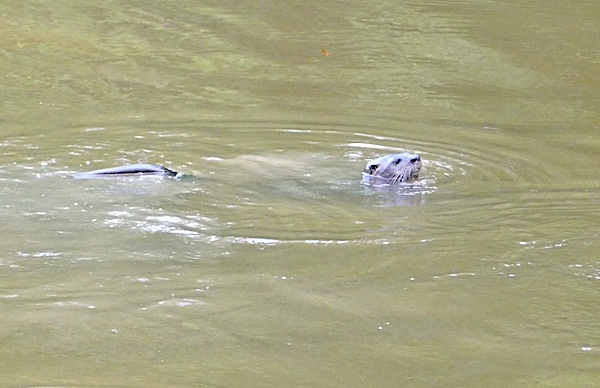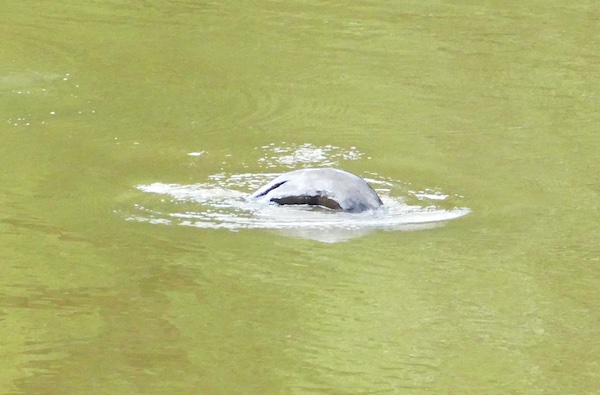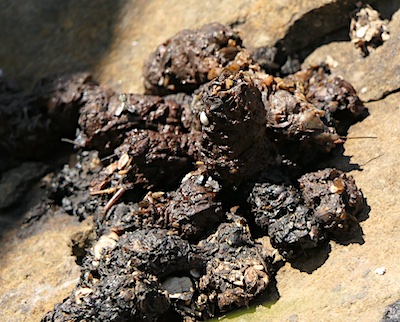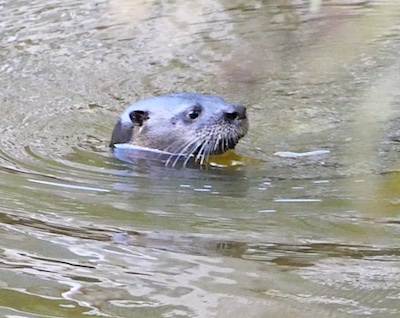Top Photo: River otter cruises by.
Standing on the boardwalk that surrounds the shallow pond in Explore the Wild I could see one, no two, brown objects on the far side of the wetlands surfacing, shaking off then quickly diving back under the water’s surface.
Could they be a couple of female or young male hooded mergansers that didn’t migrate to their breeding grounds, too young to breed and dropping in to the local ponds to see what’s available in the way of food. I didn’t have my binoculars with me, nor my camera so I couldn’t get a closer look through magnification. I had to either get closer to them or they would have to get closer to me.
They moved towards our position (Volunteer Sammie and me). They were otters and they were circling the wetland’s open water diving and hunting along the way. At one point I thought I saw three of them, but they were up and down so often and for such short duration that I couldn’t be sure. Two was good enough (later in the day, Ranger Pen and Guest Relations Asst. Mgr. Mary confirmed the sighting of three otters in the pond). Probably a family group.


Otters have been well documented here in our wetland, most often by what they leave behind, namely, scat and tracks. I’ve seen their tracks and other sign since 2009 when I saw a large golden shiner (approx. 10″) that had been bitten by what was most surely an otter. It was abandoned, then scooped back up and secreted away.


Lately, more people are seeing the wily mustelids, the actual creature, not just tracks in the snow, mud or scat left on the boardwalk. There are more and more sightings and documentation now with photos and video. Here’s a few video clips from frequent travelers on the wetland’s floating walkway, cell phone in hand.
The otter in the first clip is nibbling on a frog. Notice how, when the otter decides to leave, it takes off without the frog, then quickly returns for the morsel.
The otter in the second two clips (below) appears to be a young individual. It seems to be making location chirps or calls to its companions, then decides to go look for the rest of the group herself (perhaps this is the same group as Mary and Pen observed). This individual seems to be a young, perhaps yearling, otter. At maturity otters may reach a length of 38” to 51” (according to Peterson’s Guide to Mammals of North America – other references may state slightly different sizes).
The otter in this video is a few inches shy of 30” long. The boardwalk is 5’ wide (60”). The otter is less than half as long as the boardwalk is wide (scrub back and forth on the video timeline at about 18 – 19 sec. to get a still image of the otter stretched to near full length). It was most likely born in the spring of last year. Young otters stay with their mothers for about a year and are sexually mature at about two years. This one should be leaving soon.
An interesting fact about river otters; while they breed in spring, the female may delay giving birth until environmental conditions are optimal for the young to survive. Besides otters, embryonic diapause, or delayed implantation, is present in many different species of mammal including bears, mice, possums, and armadillos, among others.
Keep a sharp eye out for otters the next time you’re in Explore the Wild.
Speaking of eyes, river otters are supposedly nearsighted, meaning they see things up close but not far away. Things up close are sharp and clear where distant objects appear out of focus. This myopic vision may explain certain behaviors in otters.
In my encounters with otters over the years, I’ve often felt that the otter or group of otters I was watching at the time was not aware of me. The animal or animals went about their business as if I wasn’t there. As I or the otter moved in closer it would suddenly dive under the water or quickly change direction and hurry off. You get a hint of that behavior in the video above where the young chirping otter moves towards the camera then suddenly turns away, perhaps becoming aware of the photographer.

Any day you see an otter, is a good day!
Ranger Greg
Great photos, info, and insights! Thanks also for chatting with us about otters 11/1/25 after we’d seen tracks and scat with nematodes on the boardwalk and you clued us in to the likelihood of it being signs of an otter 🙂